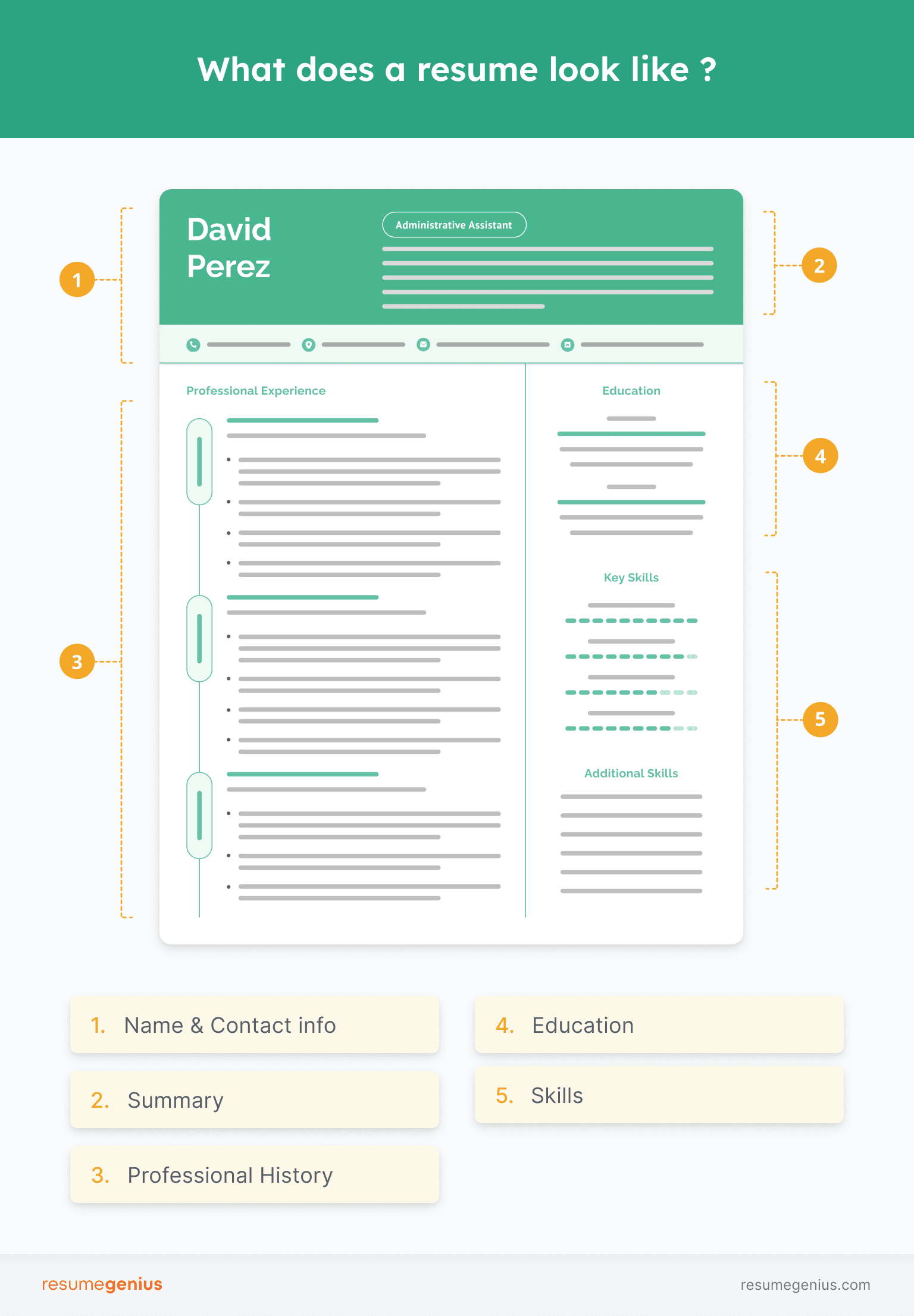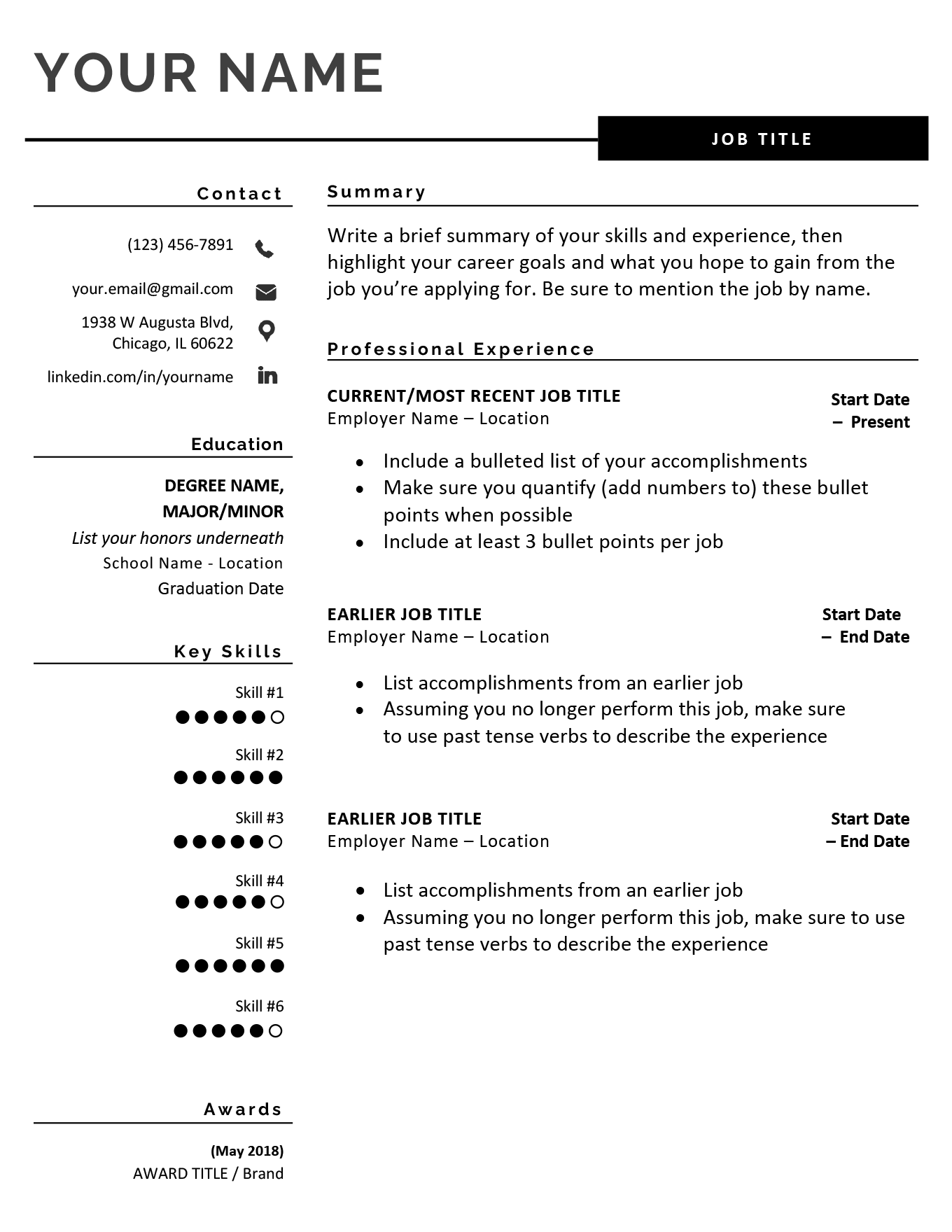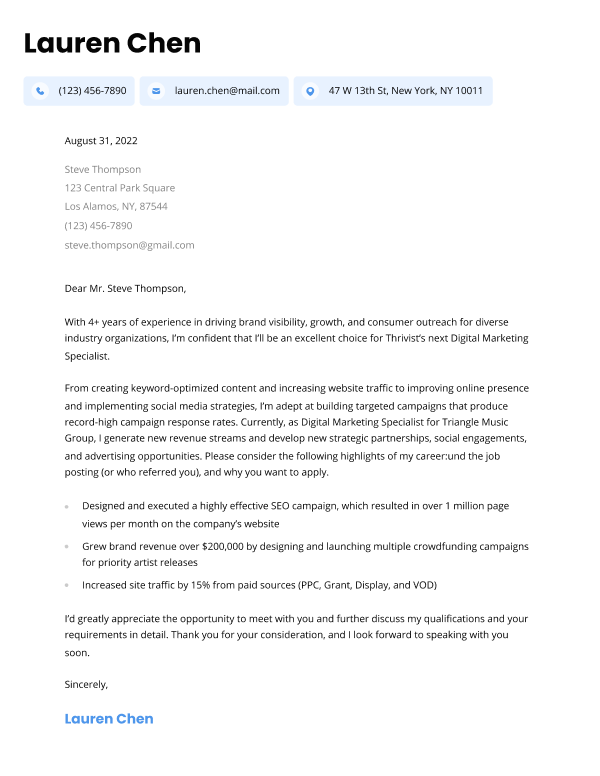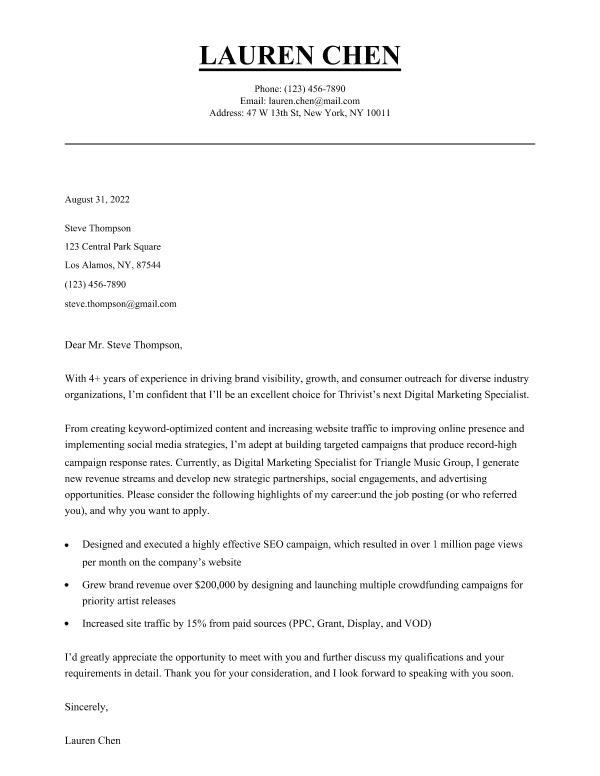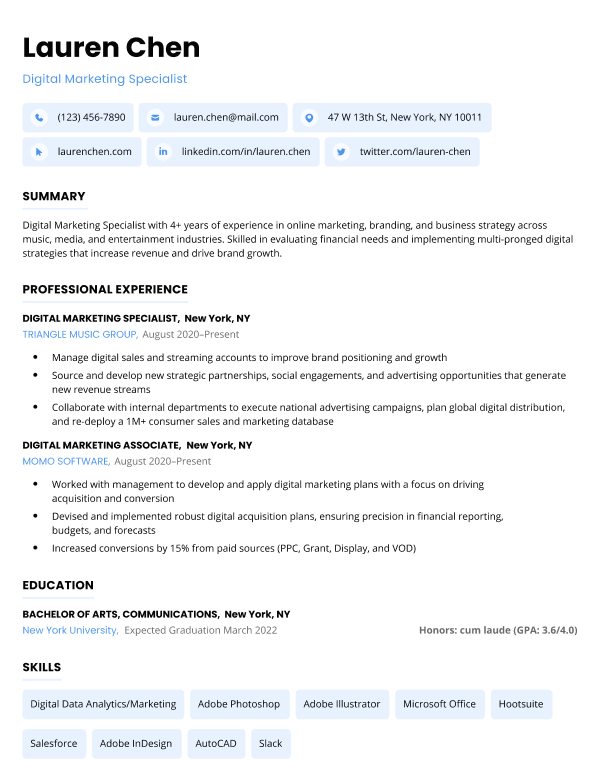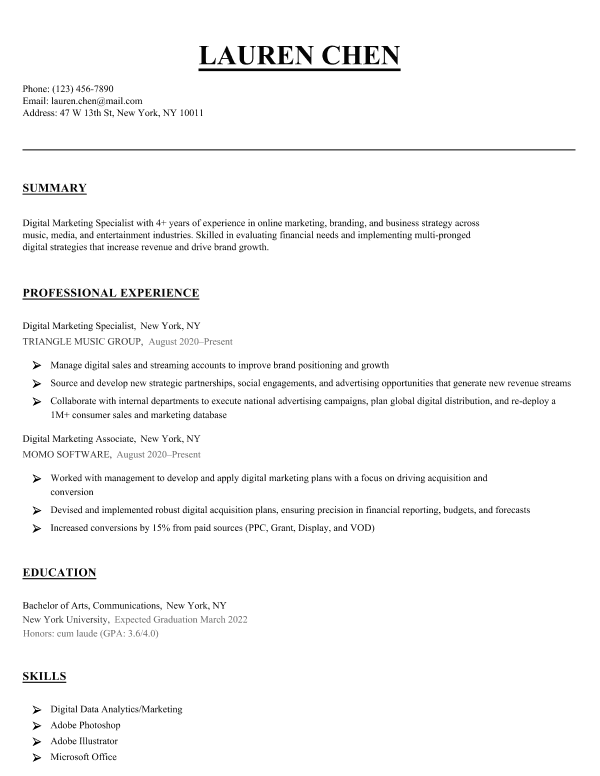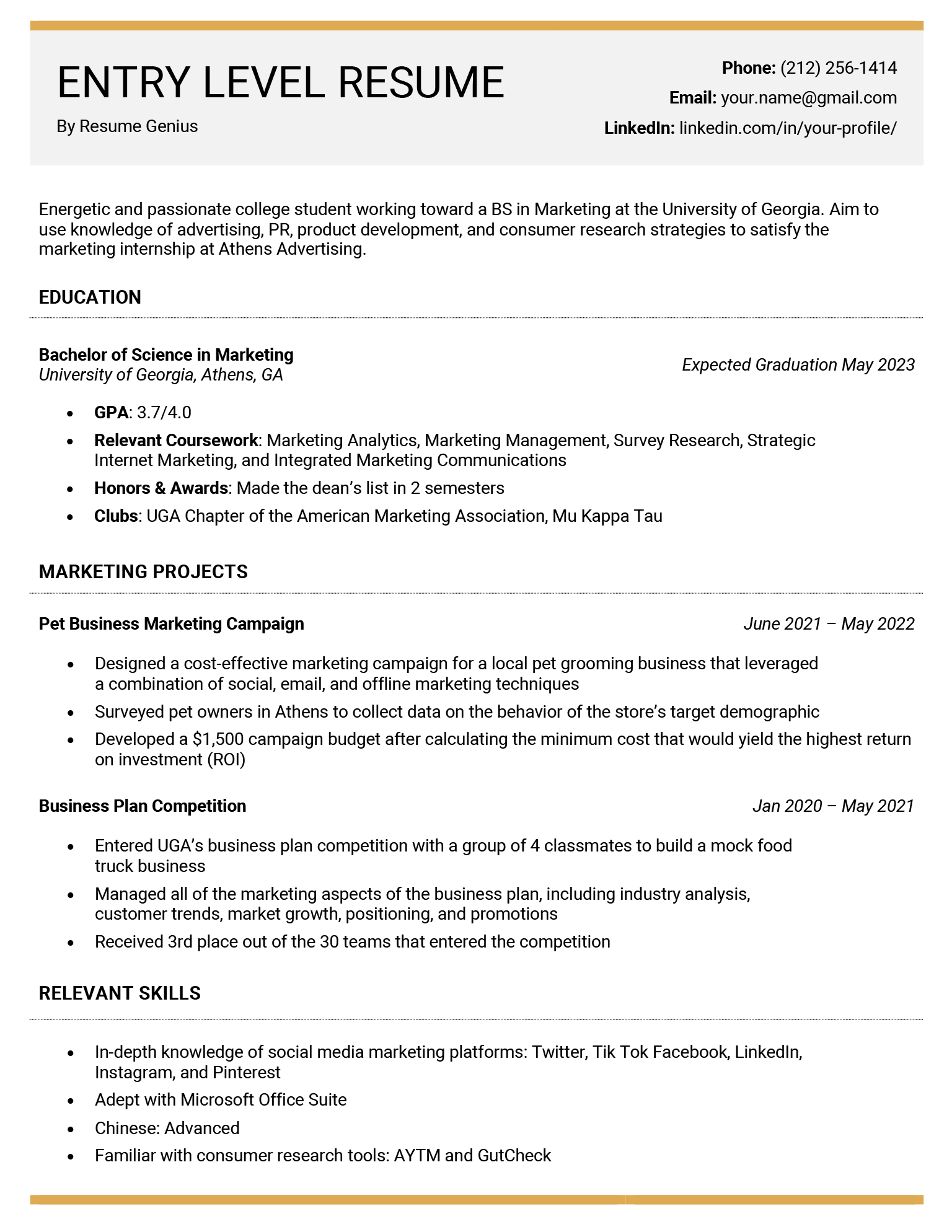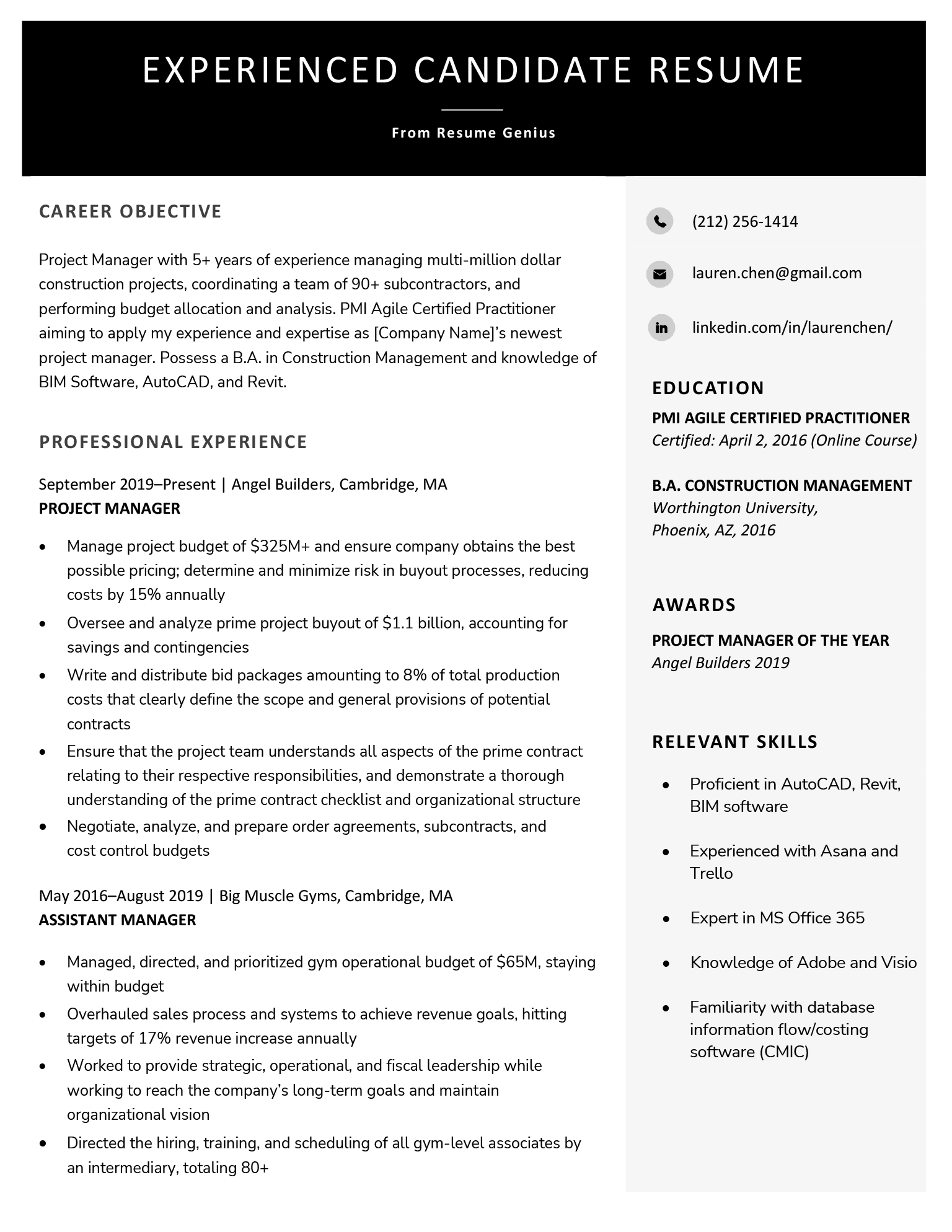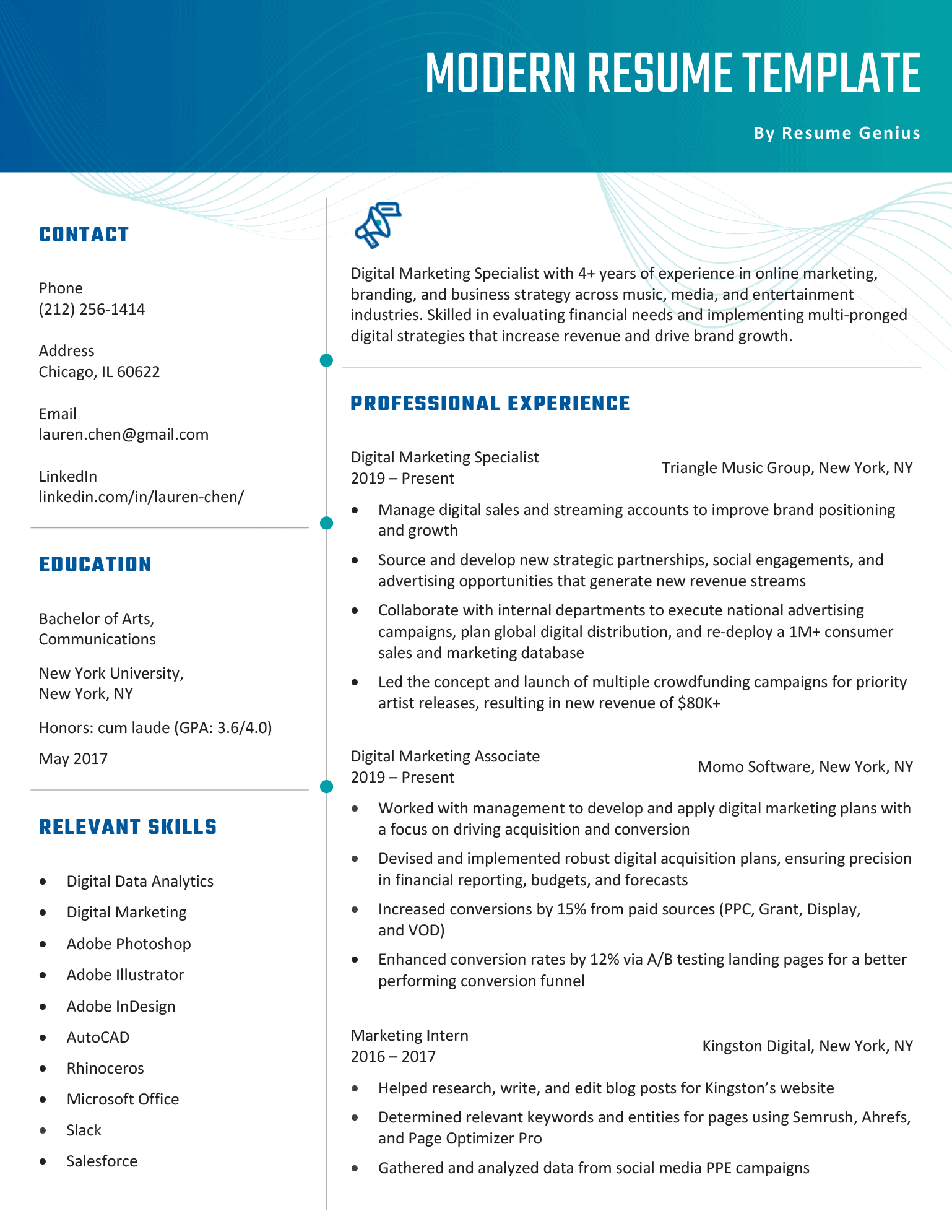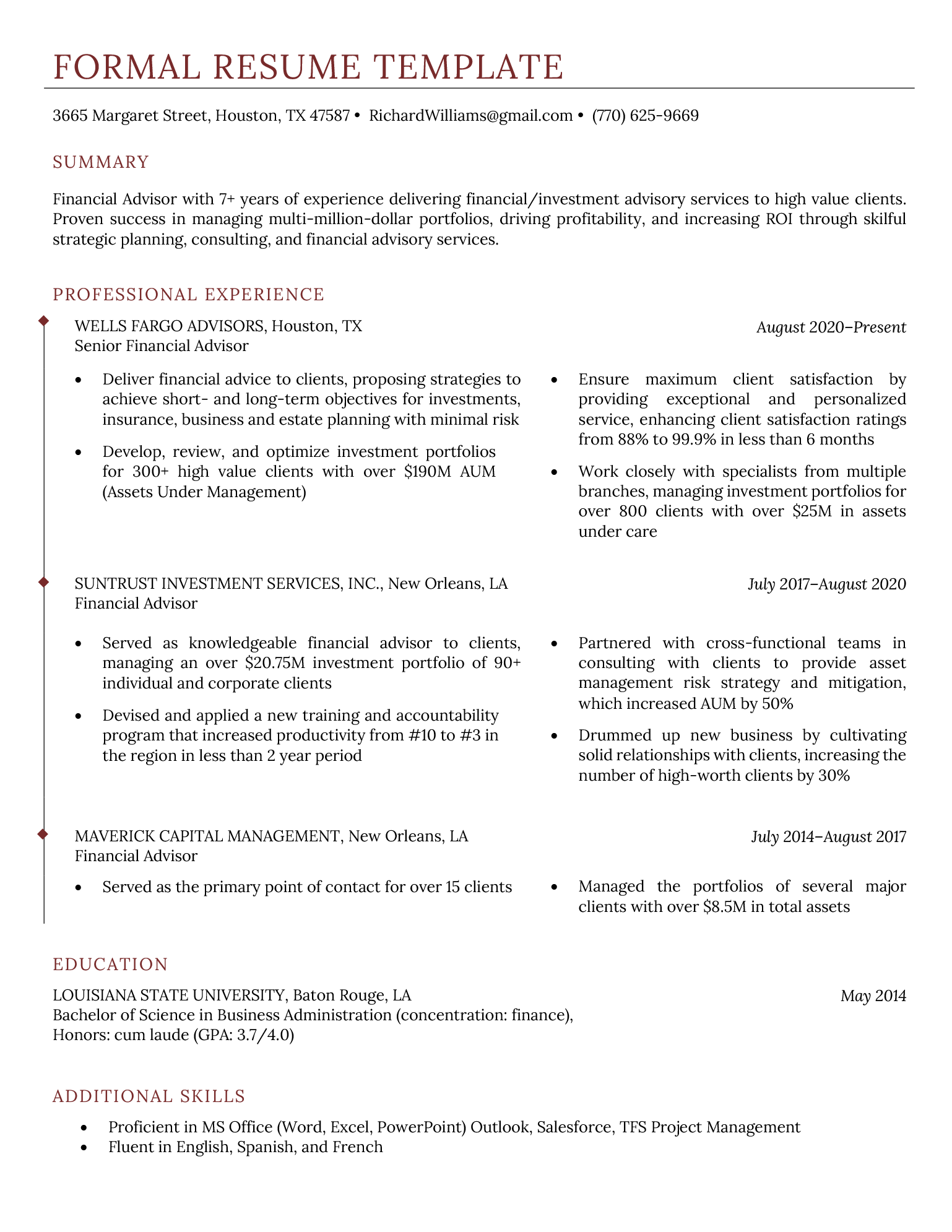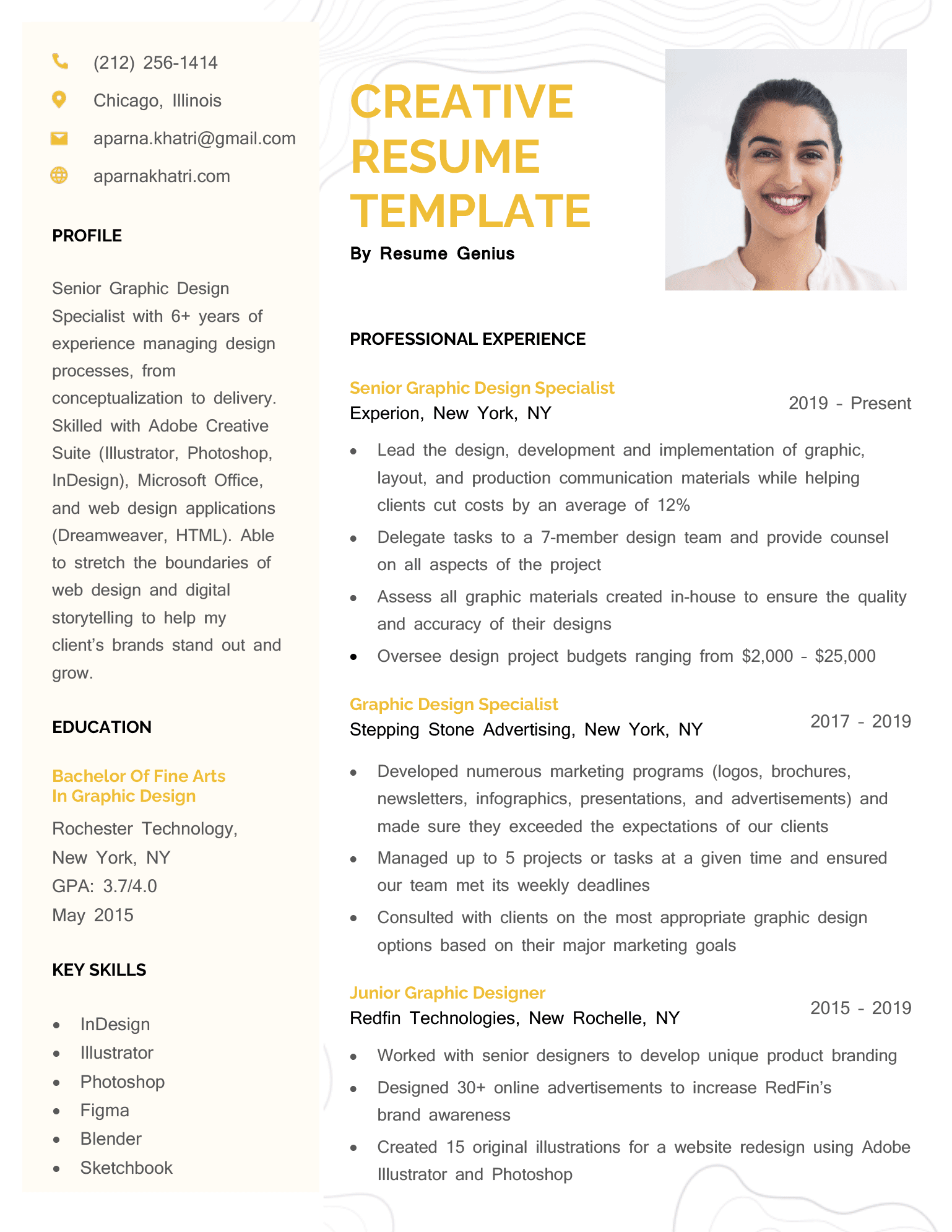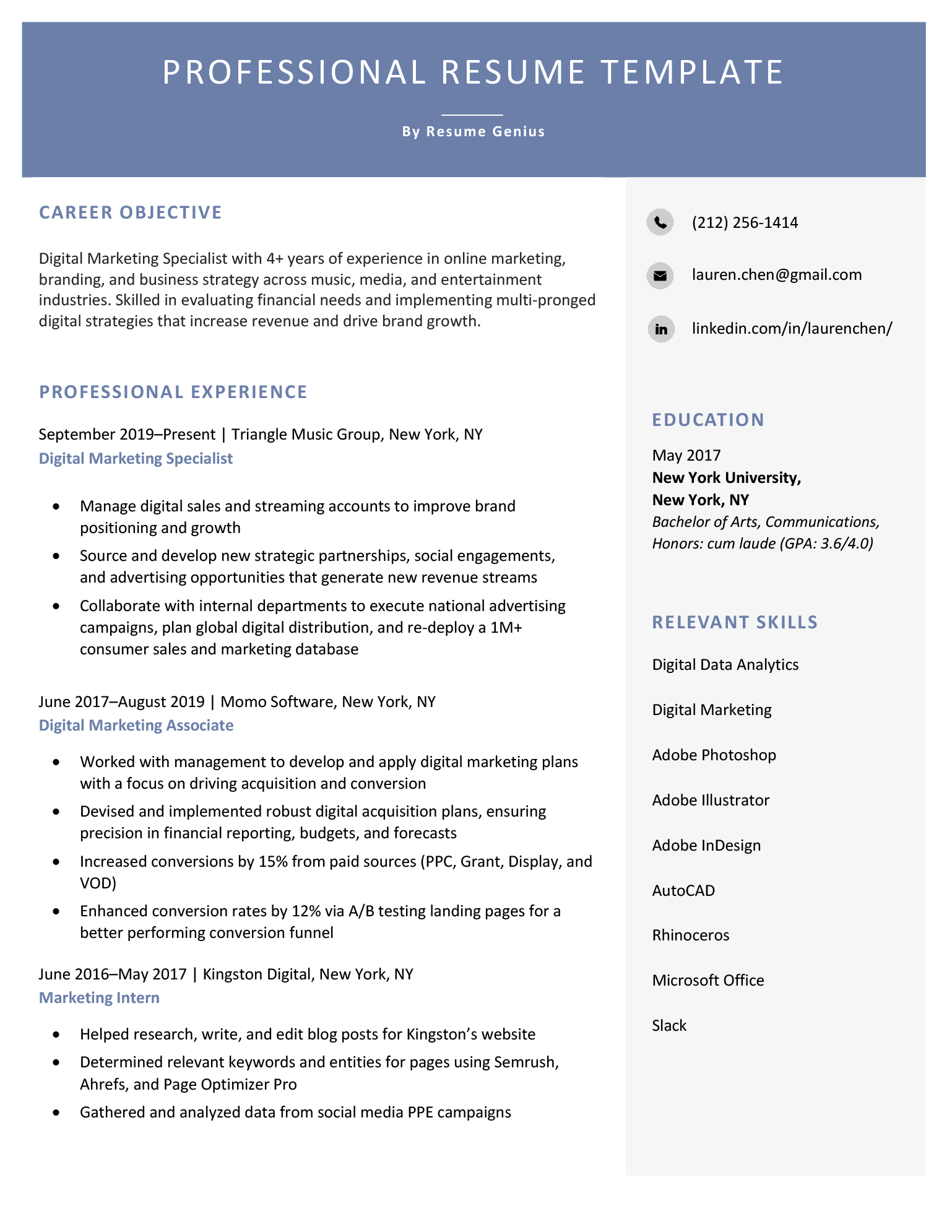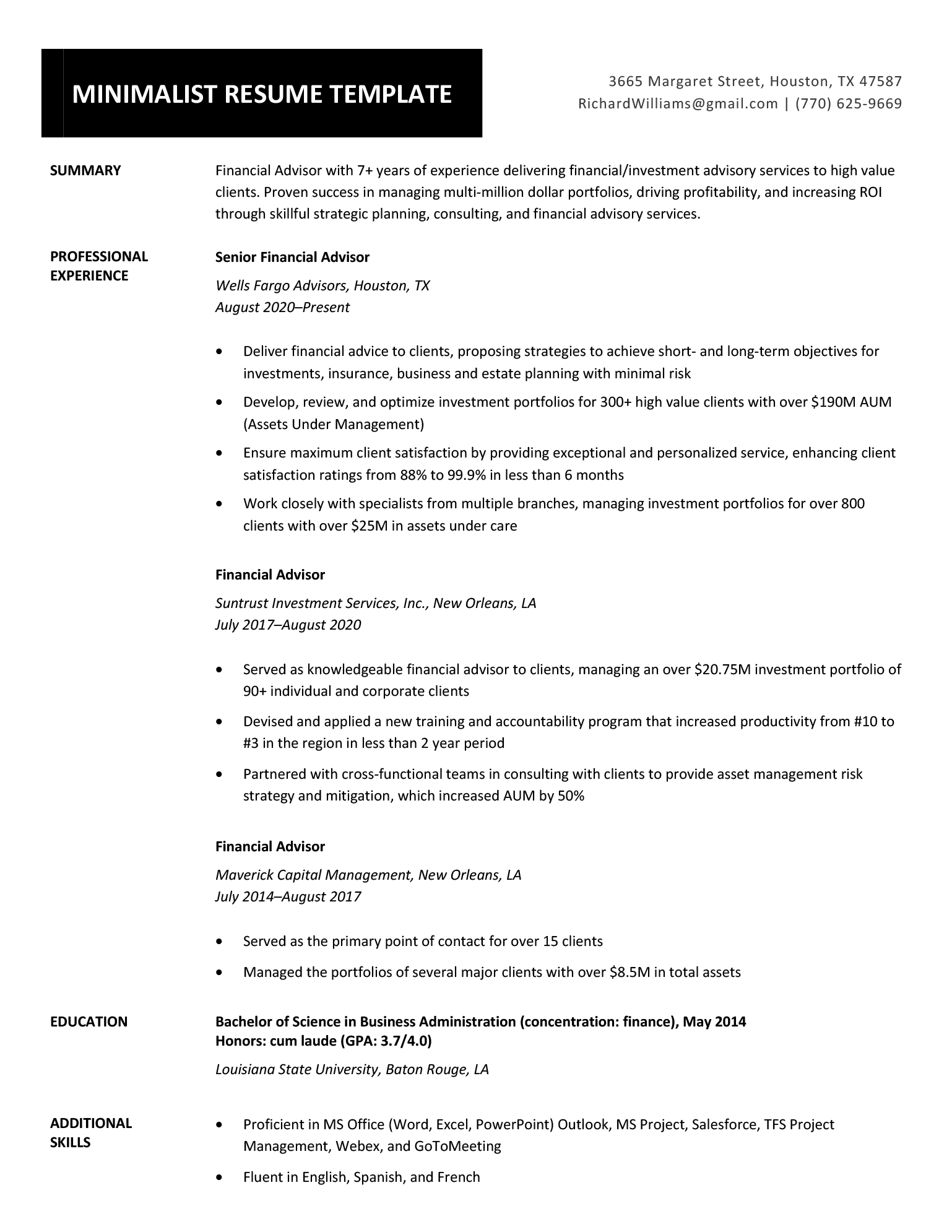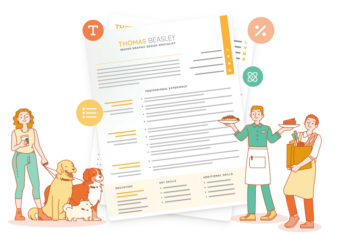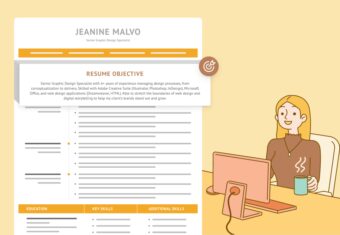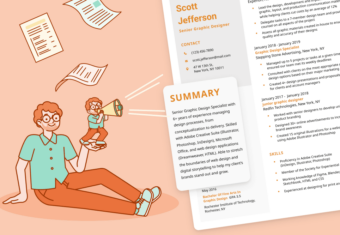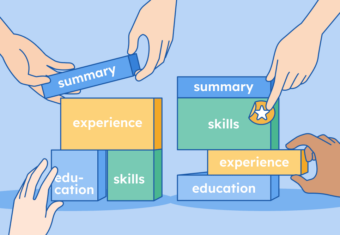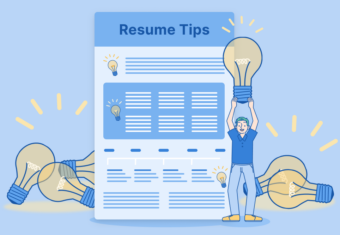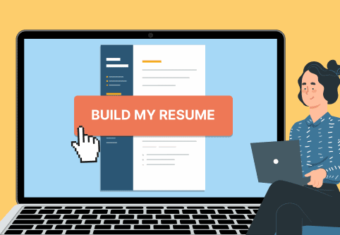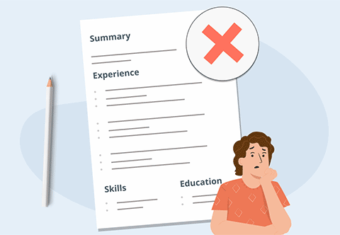Whether you’re a recent graduate or an experienced professional, you need a great resume to get the best job offers.
We explain your options for creating a resume in 2024, including everything you need to know to make sure your resume attracts recruiters and interests employers.
1. Decide your resume’s layout
Not sure how to start your resume? Before you begin writing, you need to know what a resume is and why writing one is so important to your chances of landing a job.
A resume is a document used in the hiring process that summarizes your work history, skills, and qualifications. The goal of your resume is to quickly communicate to employers why you’re the best candidate for the job.
There are a variety of ways to format your resume.
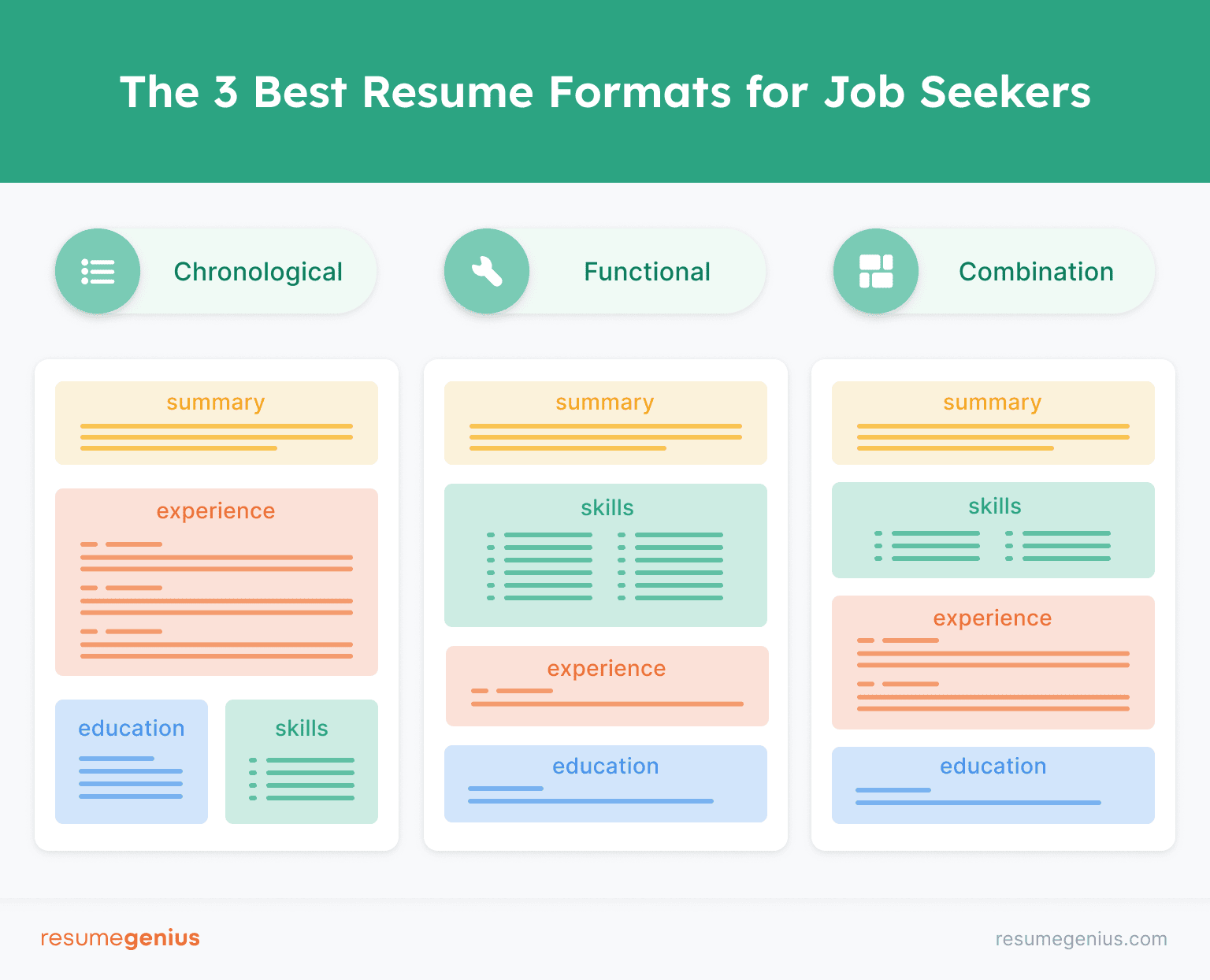
Unless you have large gaps in your work history, you should format your resume chronologically (with your most recent experience at the top) because it’s easy for employers to understand and demonstrates your career progression.
Depending on your work history or the type of job you want, you might want to consider using an alternative resume format. For example, you could use the:
- Combination resume – if you have an advanced technical skill set and work history
- Functional resume – if you have gaps in your work history and want to emphasize your skills
- Federal resume – if you’re applying to work with the federal government
- Video resume – if you’re looking for jobs that require video or performance skills
2. Pick a template with the formatting you want
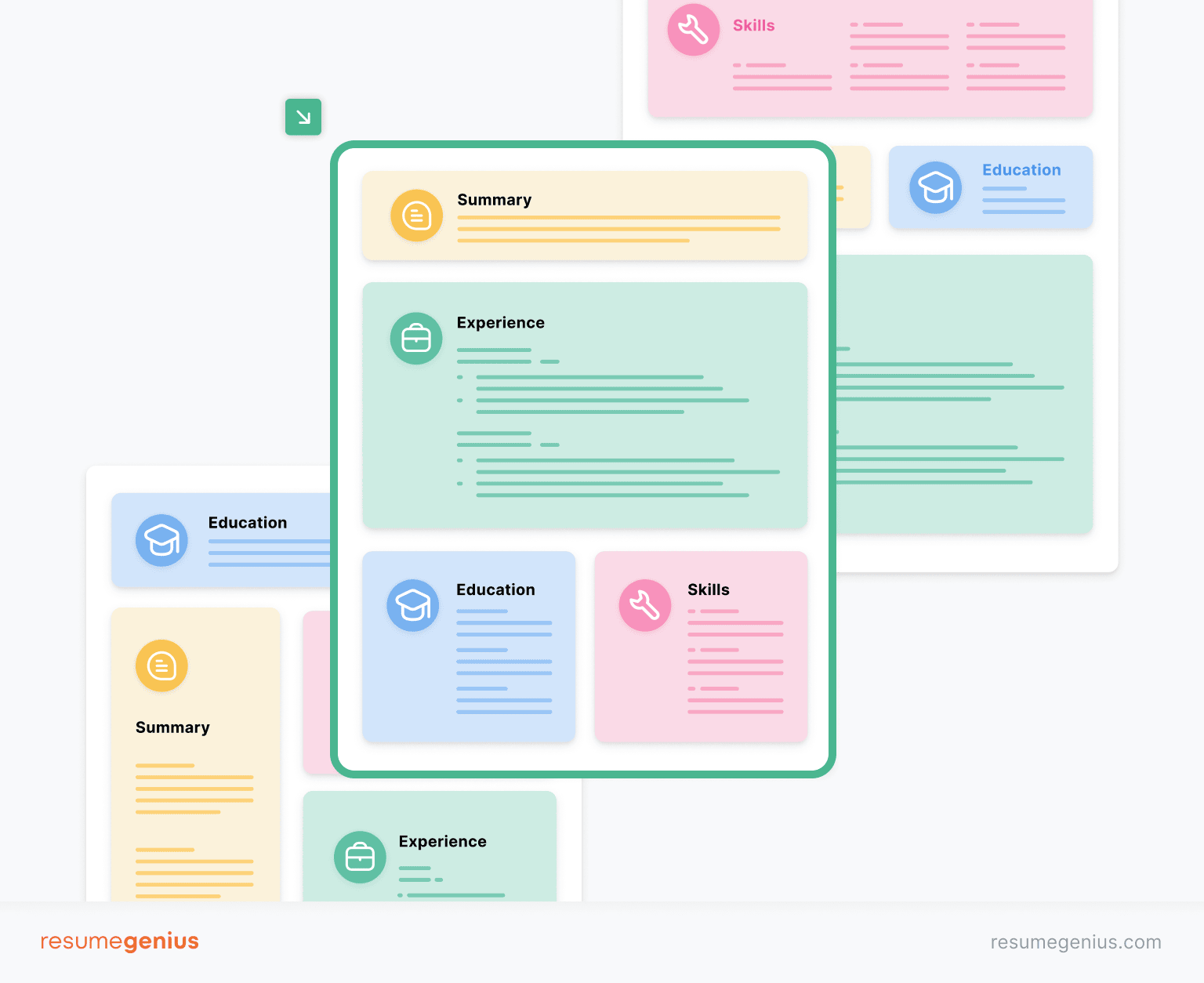
Now that you understand the basics, you need to decide how you’re going to make your resume.
One of the most convenient ways to make a resume is to download a free resume template and fill it out with your information.
To help you get started, you can download the template below and fill in each section as you follow along in this article.
This resume template includes visual skill levels, which can make your resume more eye-catching. However, if you’re applying to a more formal job you should remove them in favor of a simple list.
3. List your name and contact information
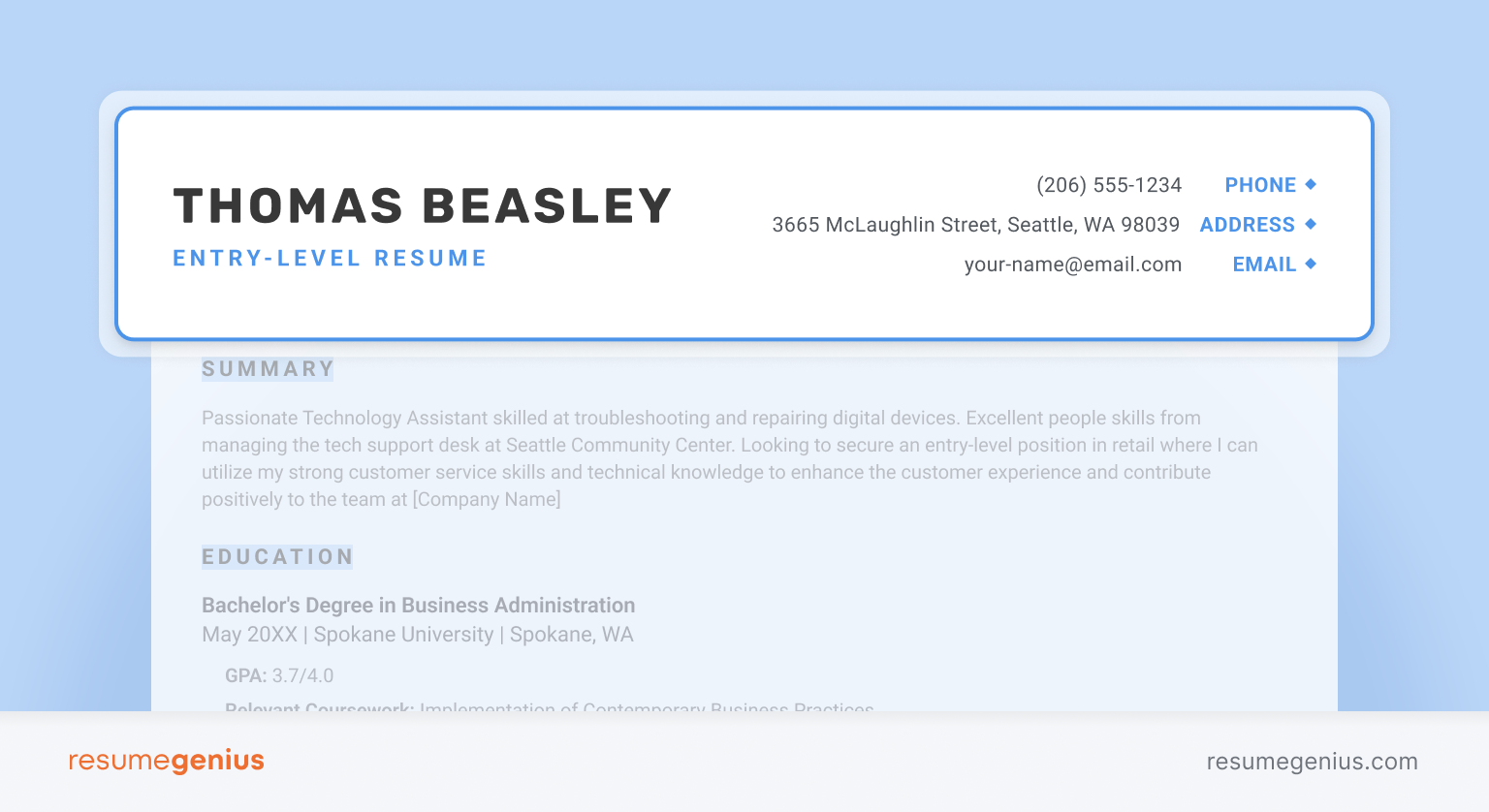
To start writing your resume, create an eye-catching resume header that quickly highlights your contact information and job title.
Your name should always be the largest element on your resume to make it stand out, so use a font size larger than 20 points.
The basic contact information on your resume includes your:
- name
- email address (use a professional one like firstname.lastname@gmail.com)
- phone number
You can also add these optional details:
- an online portfolio or website (if relevant to the job)
- your LinkedIn URL
- your mailing address (if you want to show you’re a local)
You might see some examples of resumes online that include professional headshots in the header. If you’re applying to jobs in the US, you shouldn’t include a picture on your resume because it could lead to hiring bias.
4. Add a resume summary
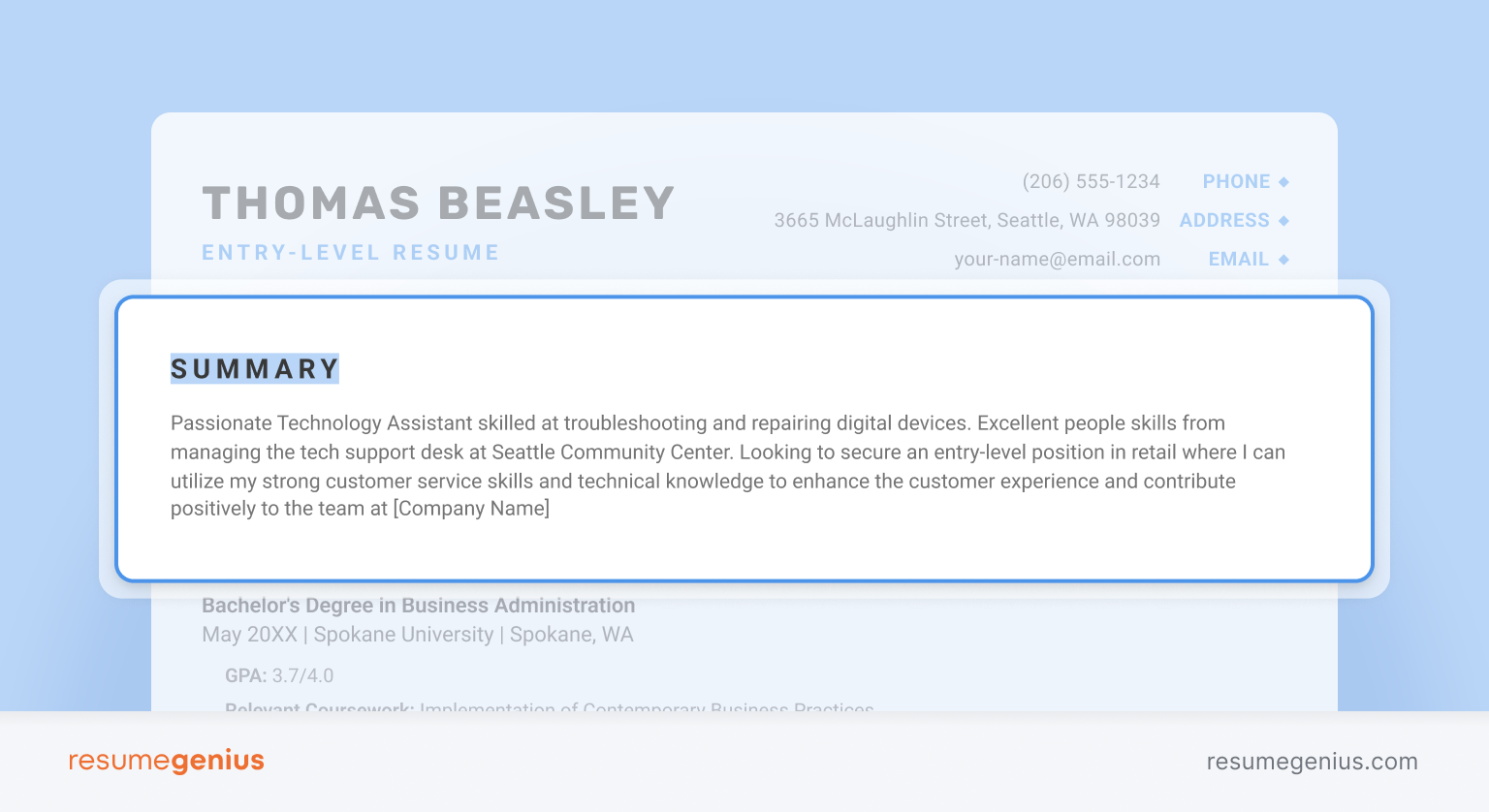
To make your resume stand out to the hiring manager, you need to communicate why you’re the right person for the job as quickly as possible. That’s where a convincing resume introduction can help.
A professional resume summary is a type of 3-5 sentence introduction that provides a snapshot of your primary qualifications, with an emphasis on your most impressive achievements and skills.
Here’s exactly how to structure a resume summary:
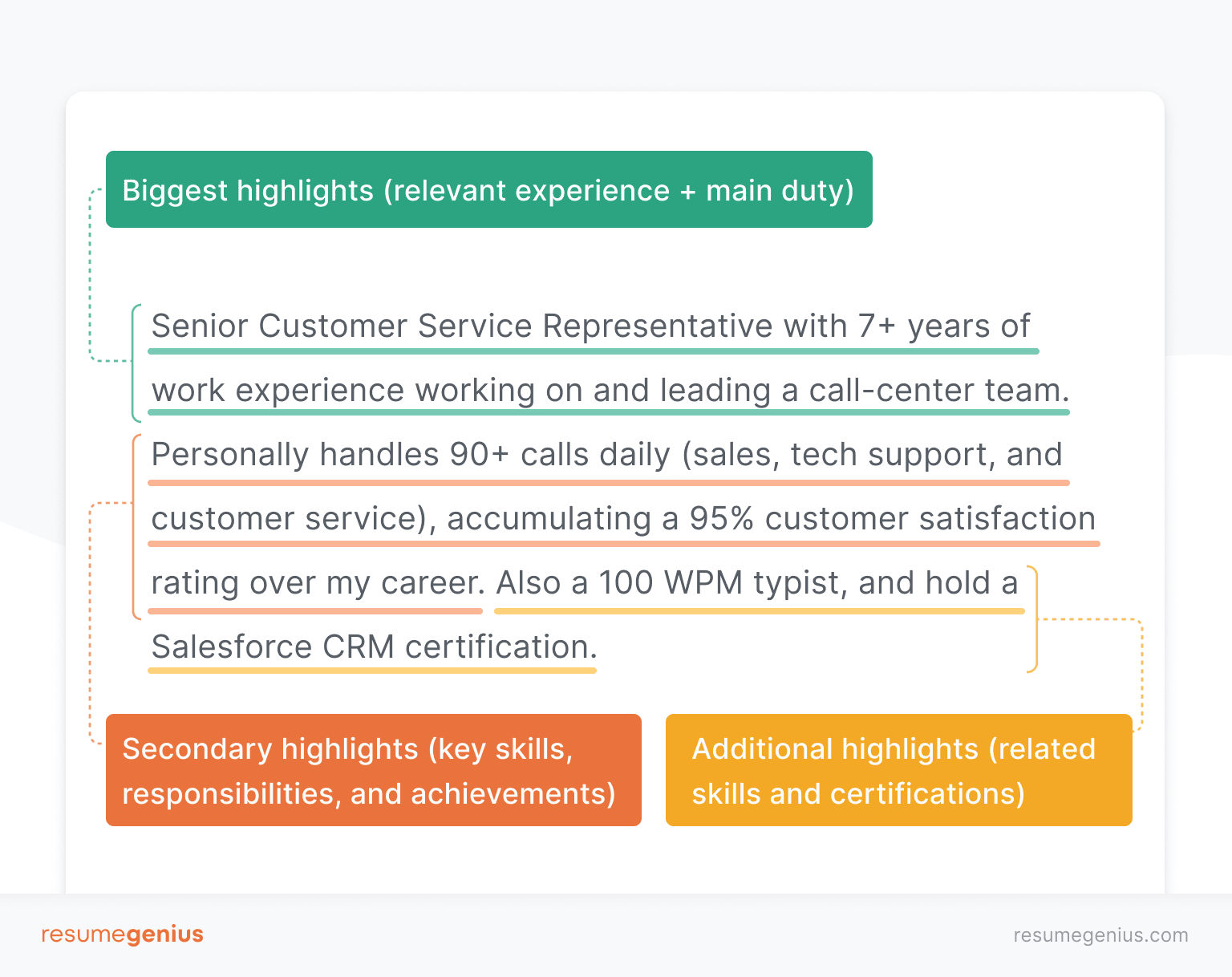
Other resume introductions
Aside from the resume summary, there are a variety of other ways to start your resume. For example, you could use a:
- Resume objective (best for first-time job seekers or career changers)
- Resume profile (best if you want to add more detail)
- Summary of qualifications (best for highly accomplished, experienced job seekers)
5. Fill out your work experience section
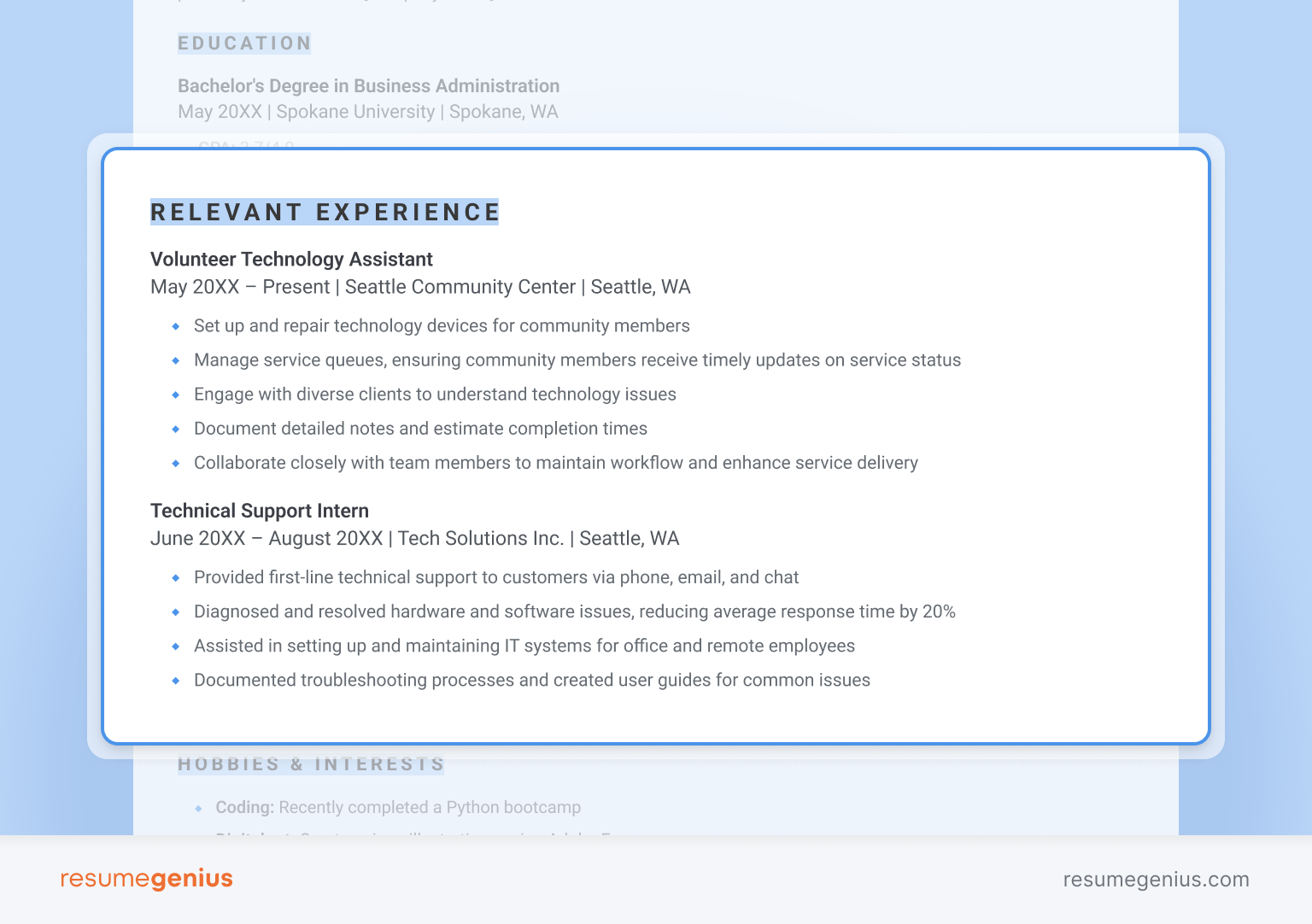
Your resume’s work experience section is what employers are usually most interested in, so it’s important to get it right.
Describe your responsibilities and achievements
List each job you’ve worked with your most recently held/current job at the top, and older jobs underneath.
For each position, list the following information:
How to structure work experience on your resume
Job title – Dates employed (year and month)
Company name – Company location (city and state)
- Three to five bullet points describing your achievements and responsibilities
- Include hard numbers in your bullet points when possible
Use present tense when describing current responsibilities, and past tense when discussing previous roles or completed projects.
Additionally, if you’ve been promoted at a job, list each role separately and specify how long you held each title.
Including multiple titles is the best way to show promotions on your resume and demonstrate to employers that you’ve grown as a professional even if you’ve only worked at one company.
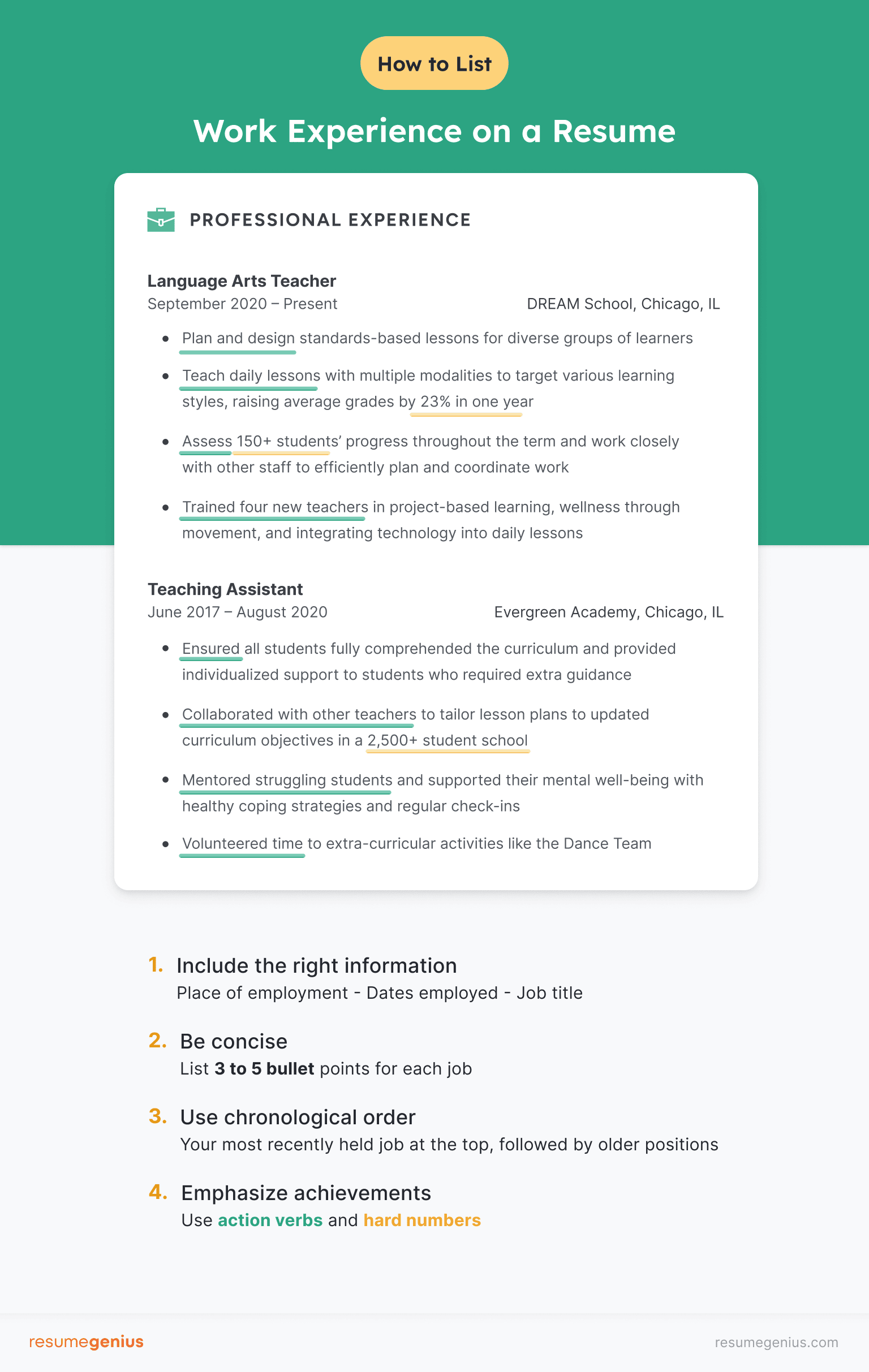
Use action verbs
Many job seekers make the mistake of starting every resume bullet point off with passive phrases like “responsible for,” which don’t do a good job of explaining what you accomplished at work.
To make your resume’s experience section best highlight your professional accomplishments, start each bullet point with an action verb that highlights specific actions you carried out.
Action verbs for your resume
- Convey
- Supervise
- Oversee
- Correspond
- Execute
- Generate
- Develop
- Streamline
- Analyze
Highlight results using hard numbers
The best way to demonstrate the impact of your professional accomplishments is to include hard numbers in your bullet points.
Hard numbers provide context to these work achievements, and show hiring managers what you’re capable of if hired.
Doesn't use numbers or action verbs
- Responsible for making media kits for company projects
Uses numbers and action verbs
- Spearheaded the development of the first media kit for all company projects, increasing annual revenue by 12%
List only your most relevant positions
Many job seekers make the mistake of listing every job they’ve ever held on their resume. The end result is in a resume that’s unfocused and cluttered.
Your resume shouldn’t be a comprehensive summary of your work experience. Think of a resume as a highlights reel for your career – showcasing only your most impressive professional achievements and skills.
To keep your resume focused, remove any positions or skills that aren’t relevant to the job you’re applying for. If you’re not sure how many jobs to list on your resume, stick to between two and four of your most relevant positions.
What to do if you don’t have work experience
Writing a resume with no work experience? No problem! You can still make an effective work experience section.
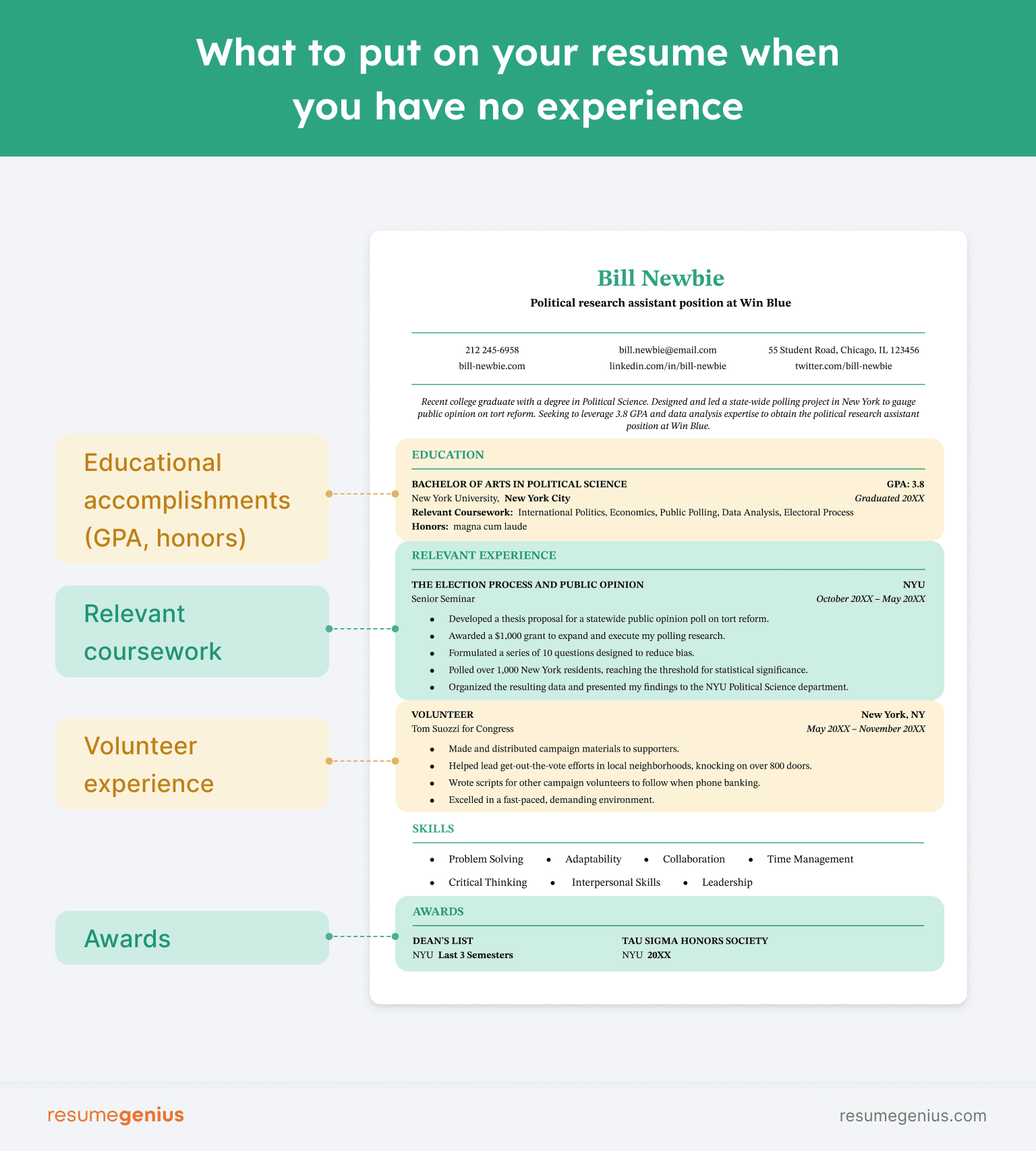
Start by renaming your work experience section to “Relevant Experience” – this will give you more flexibility. Then, list any relevant experience you have the same way you would for a full-time job. Relevant experience could be anything from independent projects to classwork.
If you’re self-employed, you can also use a “Relevant Experience” section to put your freelance work on your resume or highlight relevant experience you’ve gained through specific projects.
List volunteer work or internships
Volunteer work and internships provide opportunities to learn valuable skills that are directly transferable to full-time employment.
This makes volunteering a great way to show employers you’re qualified for the job – even if you’ve never held a full-time job.
List volunteer work on your resume in your relevant experience section with full bullet points, just like you would describe any other job. Do the same thing if you’re putting an internship on your resume.
Example of how to list volunteer experience on your resume
Volunteer, Cranford Food Distribution Center, Cranford, NJ
May 2020 – Present
- Trained 5 new volunteers, helping them develop a strong commitment to community service.
- Helped prepare food and dish out meals to over 200 people per day.
- Planned and organized two successful fundraising events, which raised the food bank over $2,500 in total.
Highlight relevant coursework
If you’re a student and you don’t have any internships yet, you can list relevant coursework on your resume to give employers an idea of what you’re capable of.
This could involve listing some relevant classes you’ve taken, or providing a full list of bullet points highlighting a school project that you worked on.
Example of how to list relevant coursework on your resume
Bachelor of Arts in Anthropology
New York University, New York City, 2020
Relevant Coursework
Social and Developmental Psychology:
- Studied qualitative research methods by reading and discussing 10+ academic articles
- Designed an online, 20-question qualitative research survey about language and identity formation
- Conducted a qualitative survey with 147 college students using Qualtrics
- Aggregated and interpreted survey results in a 10-page paper and 15-minute presentation
6. Showcase your skills
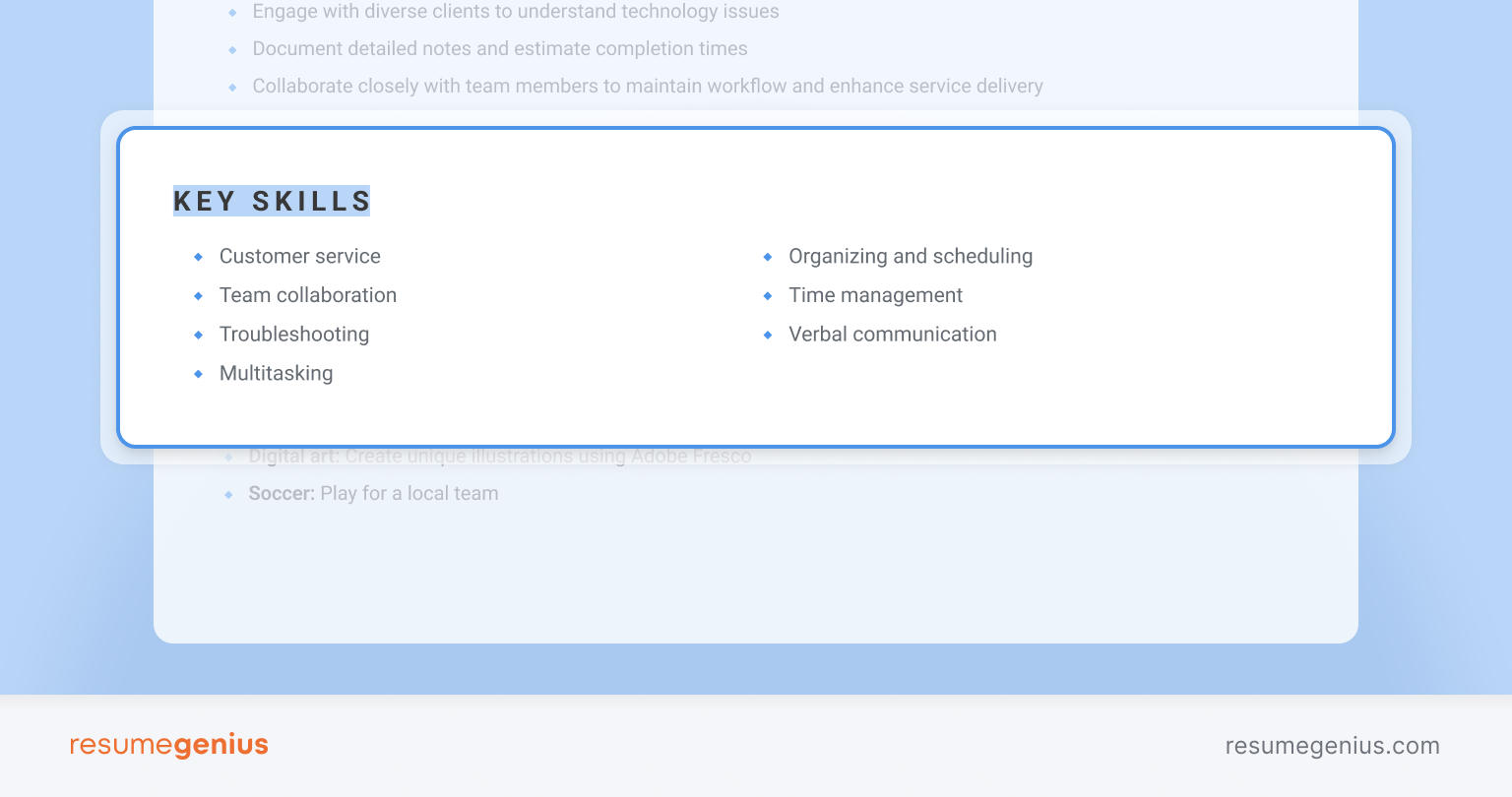
The skills section of your resume gives employers an at-a-glance view of the job-related hard and soft skills that qualify you for the role.
Hard skills are learned through specific training, workshops, work experience, or school and include the skills you need to operate equipment at work (like point-of-sale systems).
Soft skills relate to your personality, and you develop them by simply interacting with others and accomplishing daily tasks at work. Organizational skills like coordination and self-management are good examples of soft skills valued by employers.
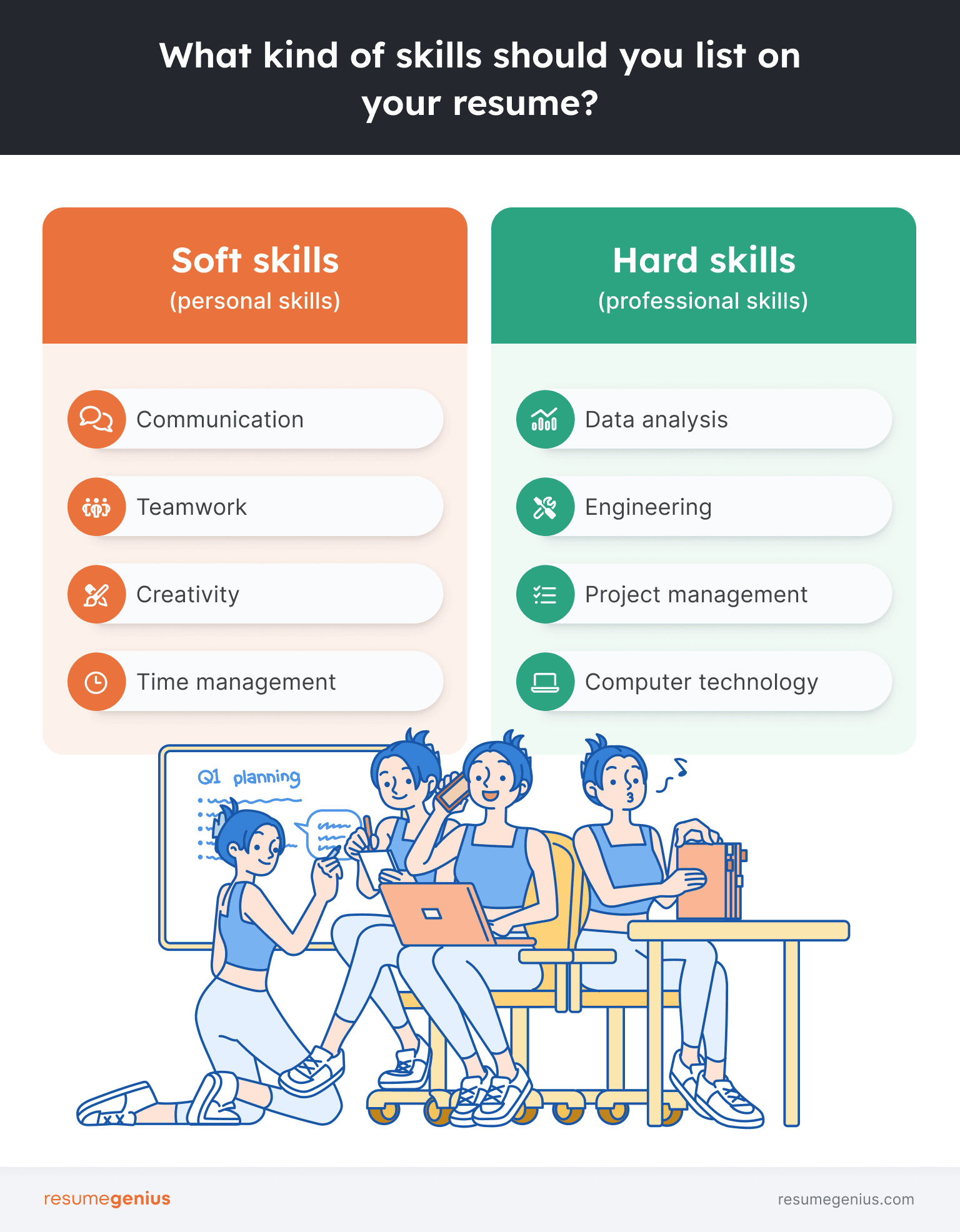
How to list your hard skills
Employers are primarily interested in your hard skills, because these are the abilities you need to perform the basic tasks associated with your job.
There are three ways you can highlight your hard skills on your resume:
- List them clearly in your skills section
- Mention them in your resume’s introduction
- Add a bullet point to your work experience section describing how you used one of your skills to achieve something
Ideally, you should combine both approaches to highlight any technical skills that are explicitly required for the job.
How to showcase your soft skills
While soft skills are valuable for any career, they’re also difficult to quantify, which make them tricky additions to your resume.
Unlike your hard skills, you should avoid listing your soft skills in your skills section. That’s because soft skills need to be demonstrated if you want employers to believe you.
The best way to highlight your soft skills is by including examples of how you used your soft skills to achieve something in your work experience section.
Here’s an example of a bullet point that effectively highlights the candidate’s leadership skills:
• Led a cross-functional team of 10 members to successfully implement a new project management system, resulting in a 20% increase in team productivity
7. Outline your education history
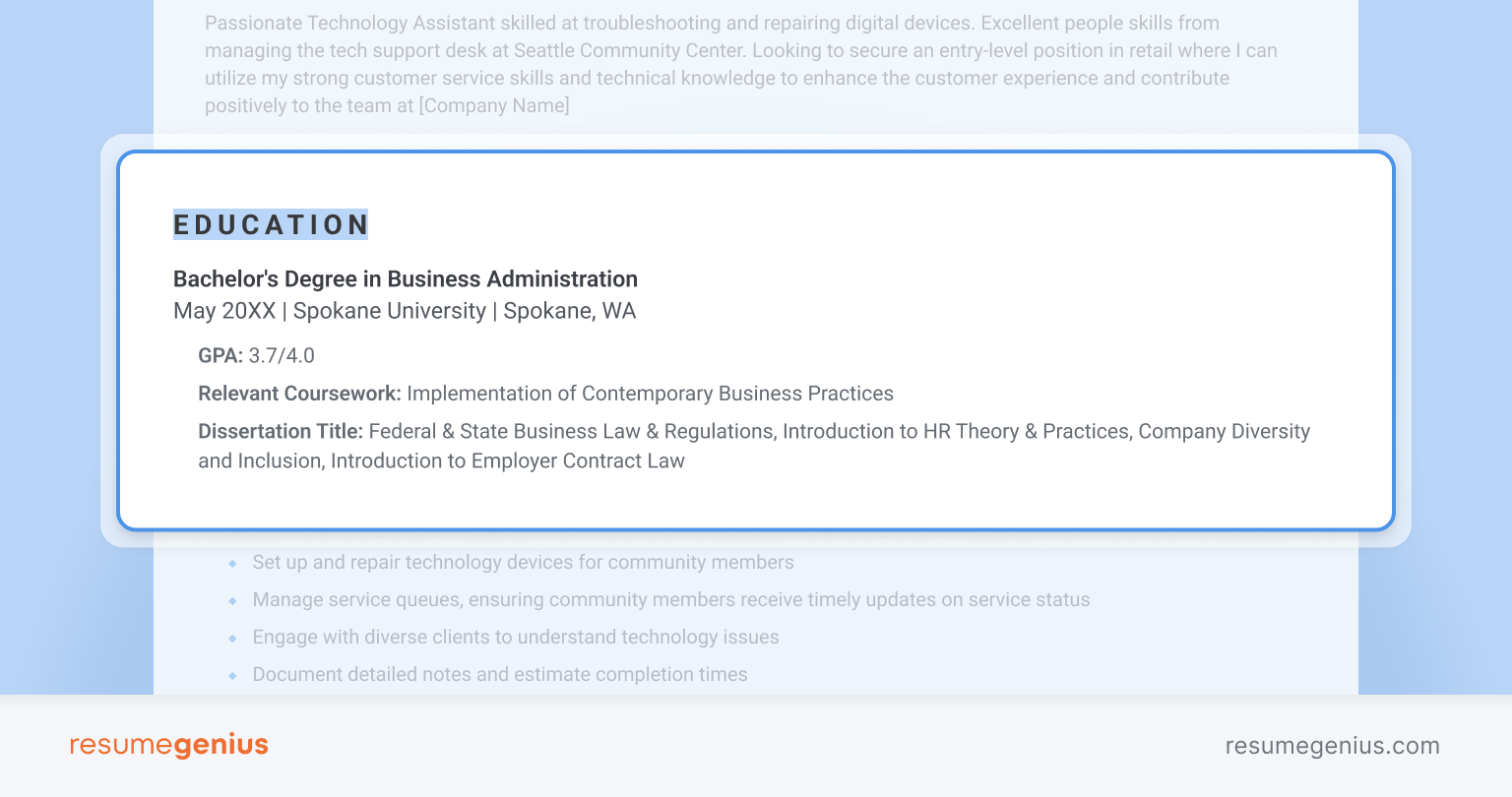
Whether you’re a recent graduate or decades into your career, it’s important to list your education history clearly.
However, the amount of detail you include in your resume’s education section will differ depending on your situation:
- If you haven’t attended college – list your high school or GED, and your graduation date.
- If you’re a college student or recent graduate – list your school, degree, graduation date, GPA (if above 3.5), and any honors you were awarded.
- If you have 2+ years of work experience – just list your school, degree, and graduation date.
- If you have 10+ years of work experience – list your school and degree.
Your education section normally comes after all of your work experience, but you should place it first if you’ve never held a full-time job or you’re writing a student resume because you’ll want extra space to talk about your academic achievements.
Your degree name
The name of the college or high school (and its location) – Your graduation date (if it’s within the last 15 years)
- Your GPA (if higher than 3.5)
- Latin honors
For teaching jobs in higher education and college applications you need to write an academic CV, which requires that you list all of your degrees, including high school diplomas, bachelor’s degrees, master’s degrees, and PhDs.
8. Add additional relevant information
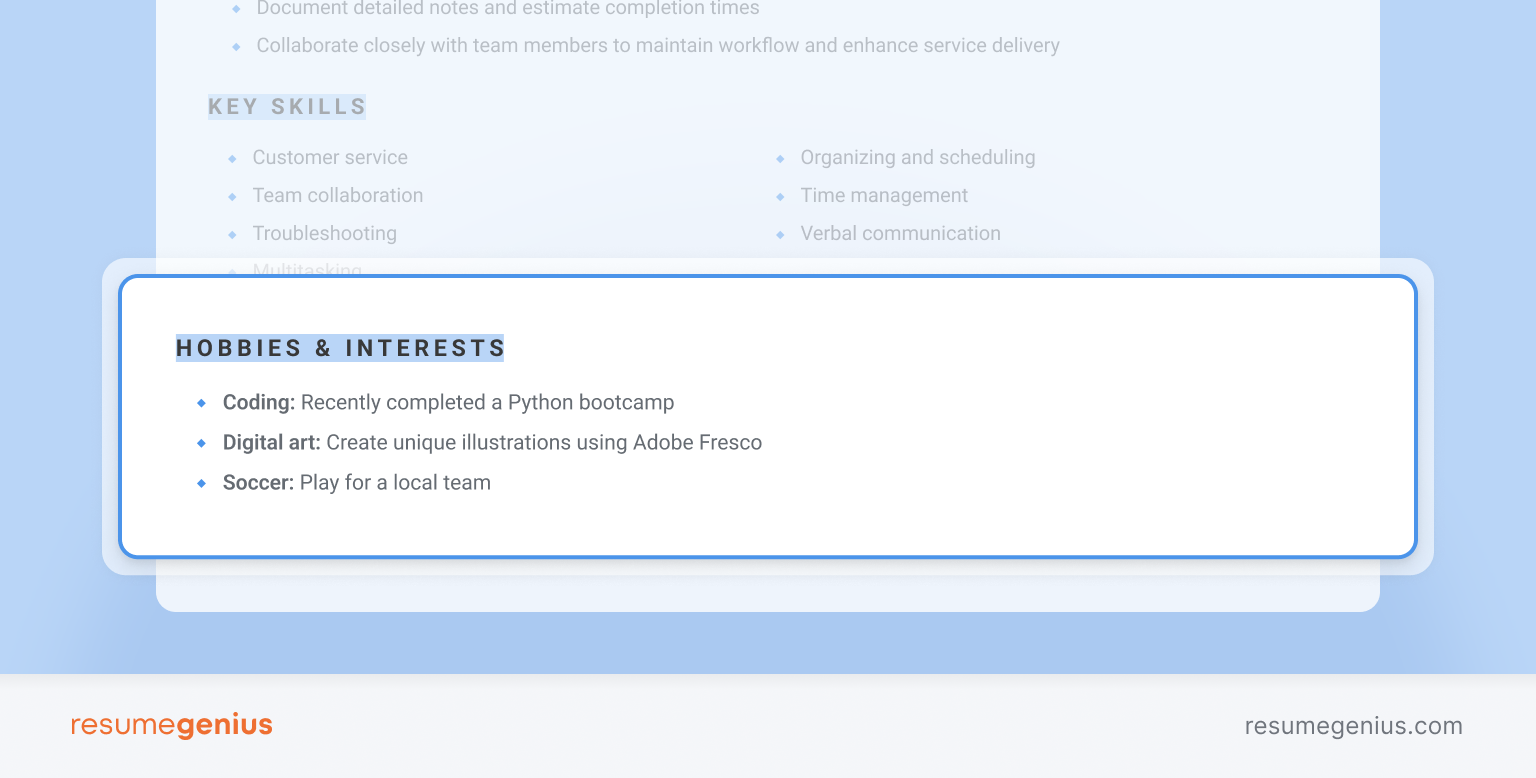
Depending on your experience and background, you should add some additional, more specific, resume sections.
One of the most common additions people make to their resume is a certifications section:
List your certifications
If you’re applying for jobs that require specific certifications to get hired, you should include a section on your resume that clearly highlights those certifications.
For example, if you work in education, medicine, or construction, you likely have more than one professional certification. In these fields, you should add a certifications section to your resume to clearly show employers that you’re qualified.
Other optional sections to put on your resume
Aside from certifications, there are many other optional sections you can add to your resume.
For example, some additional qualifications you could add a section to your resume for include:
9. Proofread your resume and finish your application
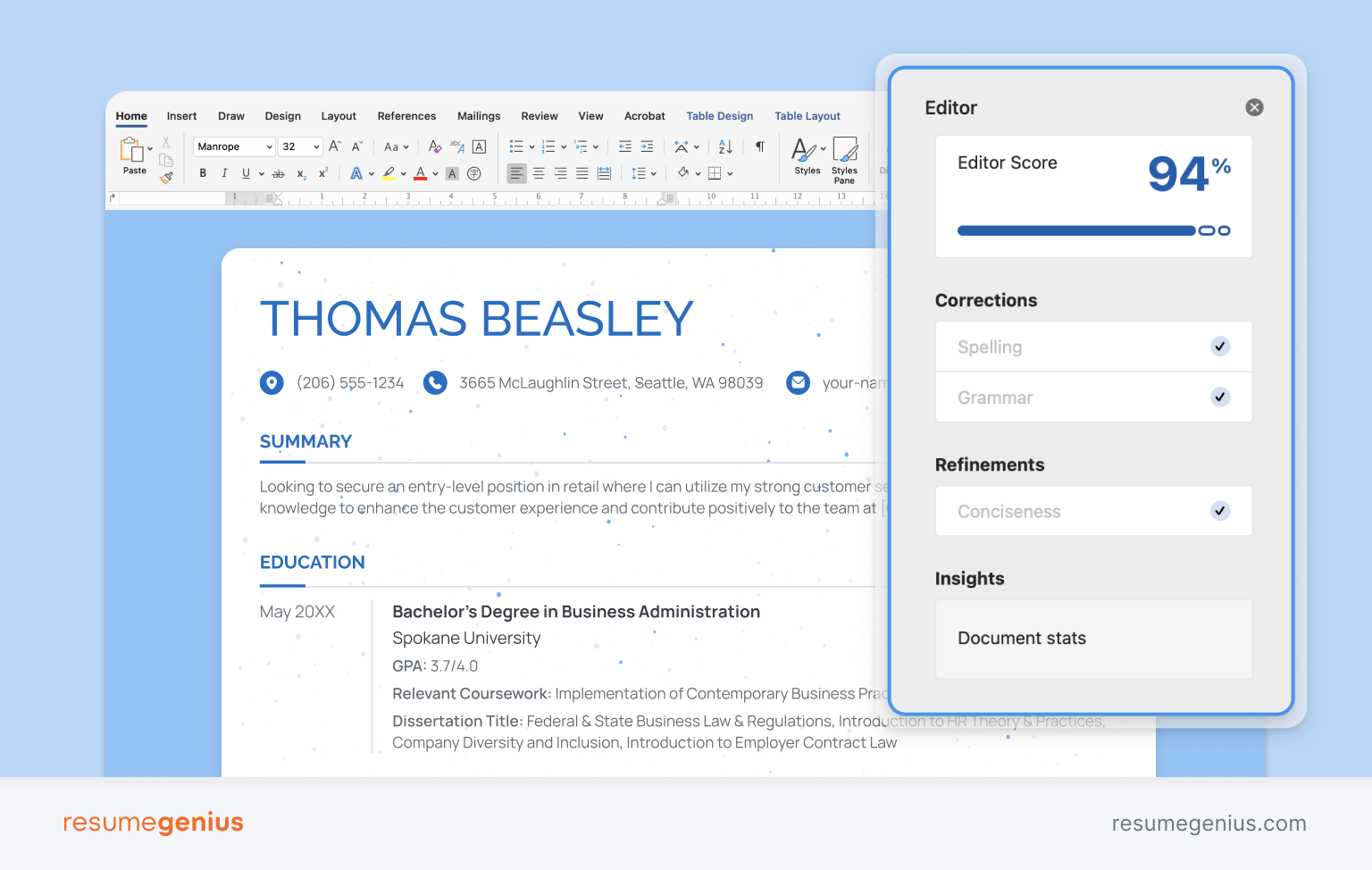
Spend some time reading through your resume at least a couple of times before you send it off. You’d be surprised how easy it is to make a typo and how hard it is to spot them in your own writing.
You should also give your resume to a friend or relative to read through so they can help you notice any mistakes on your resume.
Also consider using an AI resume checker to scan your resume for issues outside of grammar and spelling mistakes.
To help make the proofreading process easier, here’s a checklist you can tick as you complete it:
Is your contact information accurate?
Is your email address professional?
Does your resume leave out details like headshots or sensitive personal information?
Does your resume fit on one page (or two pages if you’re highly experienced)?
Is your information easy to read (fonts are above 10pt+ and sections don’t look too crowded)?
Is the design of your resume appropriate for the position you’re applying for?
Did you include all relevant sections on your resume?
Did you quantify achievements in your resume work experience section?
Did you use action verbs to describe your experience?
Does your resume address the requirements stated in the job ad?
Is your resume free of typos and grammatical errors?
Is all of your information clearly formatted and professional?
Feel free to use our on-page checklist, or make a copy in Google Docs and begin reviewing your resume.
Save your resume as a PDF (or Docx)
If the job description doesn’t specify, save your resume as a PDF. PDFs save your formatting even if you use fonts that aren’t installed on the hiring manager’s computer, so they’ll appear exactly as you want them to appear.
Your resume’s file name should be simple and clear and make it easy for the hiring manager to find later. For example, Gloria-Chen-Resume.pdf is a good file name because it contains the applicant’s name and the word “resume.”
Make a matching cover letter
Many jobs request or require that you send in a cover letter along with your resume.
So before you start sending out job applications, make sure you know how to write a compelling cover letter that highlights your strengths as a candidate.
Our free-to-use cover letter builder can make you a cover letter in as little as 5 minutes. Just pick the template you want, and our software will format everything for you.
Your cover letter should use the same design and formatting as your resume, giving your job application a polished, cohesive look.
If you’re not sure how to start your cover letter, look at cover letter examples written by other candidates in your industry.
How to make a resume quick and easy
If you’re short on time or simply don’t like writing, use a resume builder to put together a resume that earns you interviews.
Our free-to-use resume builder can make you a resume in as little as 5 minutes. Just pick the template you want, and our software will format everything for you.
There are plenty of good resume builders online to try out in 2024. Our own AI resume builder helps simplify the process of creating a resume by guiding you through each step and formats all your information for you.
Our software also provides helpful suggestions and fills out parts of your resume like your summary and work experience. At the end of the process, it formats all your information properly, so you end up with a sleek new resume that’s sure to impress hiring managers.
If you plan to use our software to create a cover letter as well, we recommend using the same template to create a visually consistent application.
Tips for making a better resume
Now that you know how to write a great resume, here are some tips for making the process as painless as possible:
You can either write your resume from scratch in Microsoft Word or Google Docs, fill out a template you find online, or use software like a resume builder:
Choose an appropriate design for your resume
The way you design your resume has a huge impact on how employers perceive you, and can make or break or chances of landing a job if you’re not careful.
Your resume design includes all the visual details like:
- the colors used on your resume
- which resume font you pick
- whether or not you use a sidebar
- how you set up your headers
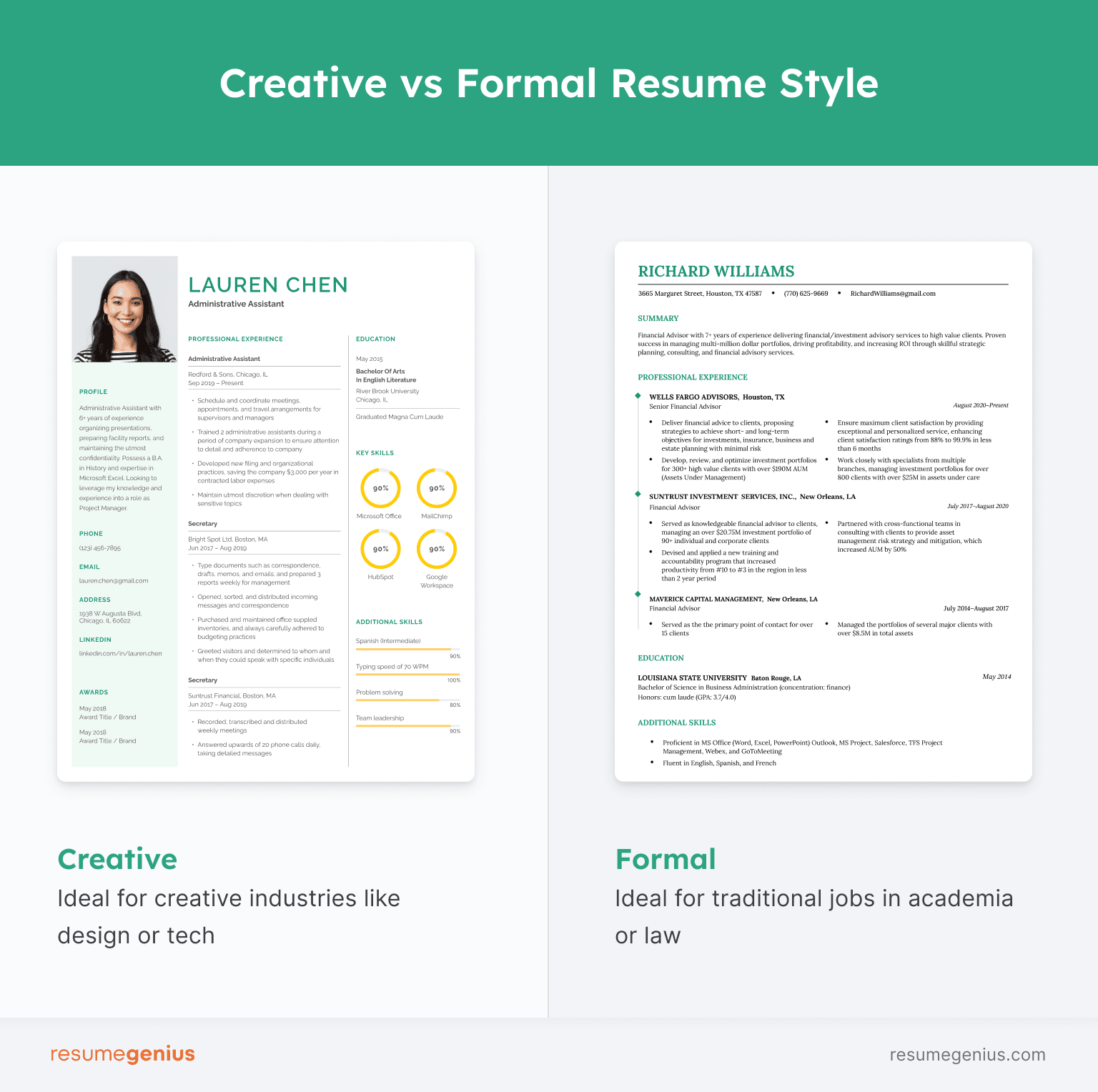
For formal industries like law or finance, stick to a simple, traditional resume style. Simple resume templates with clean lines, no graphics, and dark colors like navy blue or burgundy are most appropriate.
For creative industries like tech or marketing, you should use a more modern design for your resume. Modern resume templates include brighter colors, sans-serif fonts, and graphic details like illustrated skill levels or sidebars.
Use ChatGPT to polish your resume or get suggestions
ChatGPT is a great tool for making your resume, and is becoming more popular with job seekers in all industries.
However, before you rush to make a resume with ChatGPT, it’s important to remember that AI tools aren’t a magic wand. To get the best results from ChatGPT, you need to think carefully about how you structure your prompt, the information you provide, and the limitations of AI software.
7 resume examples and templates
The best way to check that your resume meets the standards for your industry is to look at examples written by other people in your field.
Here are two resume examples for different levels of experience to see what a strong, general resume looks like.
Entry-level resume
This college student does a great job showing off the qualities that make them a valuable candidate on their entry-level resume:
Experienced resume
This experienced project manager successfully highlights their skills and expertise on their resume:
Modern template
Ideal for jobs in marketing or tech, this modern resume template communicates to employers that you’re forward-thinking and innovative.
Formal template
Applying for work in a highly formal industry? This basic resume template is as buttoned-up as it gets. If you’re looking for work in law or finance, this is the perfect template for you.
Creative template
With its bright colors and background illustrations, this creative resume template is a good choice for careers in social media management or design.
While this template includes space for a photo on your resume, we recommend not to do this unless you’re applying for work in a field where your appearance is relevant (like acting or modeling).
Professional template
This professional resume template projects confidence, making it a great choice for executives and marketing professionals.
Minimalist template
Simple and clean, this minimalist resume template is a safe choice for just about any job because it’s highly formal but still modern-looking.
Additional resume template file types
There are countless resume templates available for a variety of platforms. For example:
- Pages resume templates
- Google Docs resume templates
- Resume templates for Microsoft Word
- LibreOffice and OpenOffice resume templates
More resume writing resources
In addition to our resume-making guide, we also have many other resources to help you build a competitive resume (no matter your industry or level of experience):
Resume writing FAQs
Still have some unanswered questions? Here are some answers to common questions about writing a resume:
Should I worry about applicant tracking systems?
If you’ve done any research about writing your resume online, you’ve probably seen warnings about how it’s essential to make your resume Applicant Tracking System (ATS) friendly – or else you’ll never land a job!
The fact is, the risk of being rejected from a job by ATS software is overstated. Most hiring managers and recruiters still manually review your resume even if they also use an ATS.
However, it’s true that many larger companies and recruitment firms use ATS software extensively. So depending on where you want to work, you should still follow best practices to make sure your resume is successfully parsed by ATS software to save hiring managers a headache when trying to read your resume.
If you’re worried about your resume being successfully scanned by ATS software, you can use a free resume checker to make sure you won’t run into any problems.
What makes a good resume?
Here’s what makes a good resume:
- A clear, professional layout and design
- Easy-to-identify contact information
- Tailoring each section to the job you’re applying for
- A resume introduction that sums up your key qualifications
- A work experience section that uses action verbs and quantifies your accomplishments
- An education section that highlights your academic achievements
- A skills section that showcases a targeted combination of hard and soft skills
Should I include references on my resume?
No, you shouldn’t include references on your resume. While people used to do this, it’s no longer considered necessary because employers will reach out to you later in the hiring process if they want to hear from your references.
Including a reference section on your resume just uses up valuable space that would be better put to use elaborating on your achievements and skills.
How many jobs should you list on a resume?
You should list three to four jobs on a resume. As a general rule, you should highlight the last 10-15 years of work experience on your resume, depending on your career level and the job you’re applying for.
If you have a lot of relevant experience that goes back further than this, you can include some additional positions, but it’s not necessary to list every job you’ve ever held.
How do you make a resume for free?
There are a couple of ways to make a resume for free:
- Use word processing software – if you have access to Microsoft Word or Google Docs, you can easily build a resume for free.
- Use a resume template – download a resume template for Google Docs or Word and fill out each section with your information for a professionally designed free resume.
No matter which method you choose, always proofread your resume at the end to make sure it looks professional and there aren’t any mistakes that could hurt your chances of landing a job.
What can I do if I still have questions about making my resume?
If you still have questions about making your resume, here are some additional answers to more specific questions:
- Can I send a resume instead of a CV?
- How many jobs should you list on a resume?
- Is it OK to lie on your resume?
- Is it resume or resumé?
- Can I make a resume on my phone?
- Should I put a job I got fired from on my resume?
- Should I put my resume on LinkedIn?
- Can you say “I” on a resume?
- How bad is a gap on my resume?
- What should you name your resume file?



